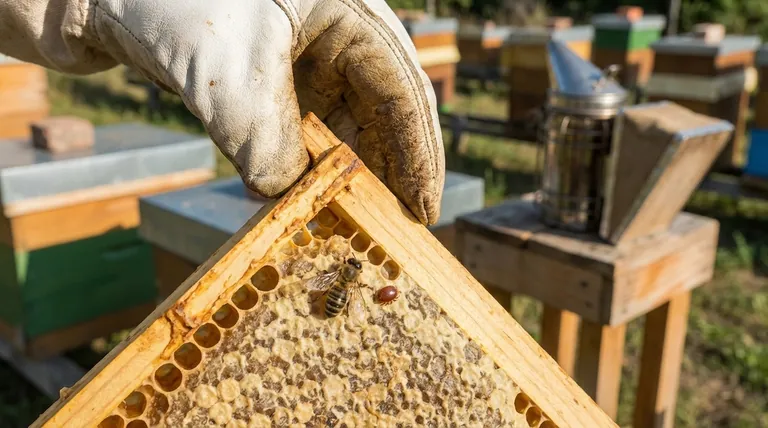In short, Varroa mites fundamentally transformed beekeeping from a practice of animal husbandry into a constant battle against a devastating parasite. The introduction of the Varroa destructor mite led to unprecedented annual colony losses, with some beekeepers reporting losses as high as 60%, and made active pest management a mandatory skill for survival.
The core problem is not just that Varroa mites are parasites; it's that they act as vectors for deadly viruses. By feeding on bees and transmitting more virulent pathogens, mites are the primary driver of colony collapse and poor health in modern apiaries.

How a Varroa Infestation Unfolds
The Varroa destructor mite is an external parasite that originally targeted the Asian honey bee. When Western honey bees were introduced to Asia, the mite shifted hosts, with devastating consequences for a bee population that had no natural defenses.
The Direct Attack on Bees
Mites feed on the fat bodies of both adult bees and their developing young (larvae and pupae). This organ is critical for a bee's immune function, detoxification, and energy storage.
This direct feeding weakens the individual bee, compromises its immune system, and reduces its lifespan, leading to a steady decline in the colony's overall health and population.
The Hidden Threat: Reproduction
The most significant damage occurs out of sight. A mated female mite, known as a 'phoretic' mite when seen on an adult bee, will enter a brood cell just before it is capped.
Inside the sealed cell, she lays eggs that hatch and feed on the single, defenseless bee pupa. This is where the mite population multiplies exponentially, overwhelming the colony from within.
The Real Killer: Virus Transmission
While the parasitic feeding is damaging, the mites' role as a disease vector is what makes them truly catastrophic. Mites effectively act as "dirty needles," spreading pathogens from bee to bee.
Amplifying Deadly Viruses
The most significant pathogen transmitted is the Deformed Wing Virus (DWV). In the absence of mites, DWV is a relatively minor infection.
However, when transmitted directly into the bee's hemolymph (blood) by a feeding mite, the virus becomes far more virulent and deadly.
The Impact of DWV
Infected bees emerge with shrunken, useless wings, rendering them unable to fly. Since a bee's primary function is to forage for the colony, this disability is a death sentence for both the individual and, eventually, the entire hive.
Understanding the New Reality for Beekeepers
The arrival of Varroa mites created a clear dividing line between pre-Varroa and post-Varroa beekeeping. The old methods were no longer sufficient to keep colonies alive.
From Husbandry to Pest Management
Beekeeping now requires a technical understanding of the mite's life cycle and a strategy for eradication—a difficult task of killing a bug on another bug without harming the host.
The Need for Constant Vigilance
Beekeepers cannot afford to be passive. They must constantly monitor mite levels through methods like alcohol washes or sugar shakes to assess the infestation rate.
Failing to monitor and treat a colony is no longer an option. An infestation level of 3% or higher is a widely accepted threshold that requires immediate intervention to prevent the colony's collapse.
Applying This to Your Understanding
Understanding the Varroa mite is central to understanding the challenges of modern beekeeping.
- If your primary focus is colony health: Recognize that Varroa mites are the single greatest threat, primarily because they weaken bees and amplify deadly viruses like DWV.
- If your primary focus is the beekeeper's role: Appreciate that modern beekeeping is an active, data-driven practice requiring constant monitoring and treatment to prevent catastrophic losses.
Effectively managing this single parasite has become the most critical factor in ensuring the survival of honey bee colonies today.
Summary Table:
| Key Aspect of Varroa Impact | Description |
|---|---|
| Primary Threat | Acts as a vector for deadly viruses, primarily Deformed Wing Virus (DWV). |
| Colony Losses | Can cause annual losses as high as 60% in untreated colonies. |
| Action Threshold | An infestation level of 3% or higher requires immediate intervention. |
| Beekeeper's Role | Shifts from passive husbandry to active, data-driven pest management. |
Protect Your Apiary with Professional-Grade Equipment
Varroa mite management is non-negotiable for modern beekeepers. HONESTBEE supplies the durable, effective beekeeping supplies and equipment that commercial apiaries and distributors need to monitor, treat, and protect their colonies from this devastating pest.
Ensure your operation's survival and productivity. Contact our wholesale experts today to discuss equipment solutions tailored for commercial-scale Varroa control.
Visual Guide

Related Products
- Professional Bee Smoker with Elongated Spout and Durable Bellows for Beekeeping
- Commercial Grade Vertical Electric Bee Sweeper for Bee Removal
- Wholesales Dadant Size Wooden Bee Hives for Beekeeping
- Ventilated Adult Beekeeping Helmet Hat for Beekeepers
- Professional In-Hive Frame Bee Feeder by HONESTBEE
People Also Ask
- What is a bee smoker and how does it work? Master the Tool for Calm, Safe Hive Inspections
- What are some alternatives to using smoke in beekeeping? A Guide to Gentle Hive Management
- What are the differences between stainless steel and galvanized steel bee smokers? Choose the Right Smoker for Your Apiary
- Do bee smokers work? Unlock the Secret to Calm, Safe Hive Inspections
- How does smoke affect honey? Balancing Bee Safety and Honey Purity



















